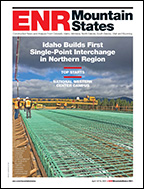Time was of the essence: It was even built into the bidding process as a key factor in the $8.5-million project to replace the collapsed Interstate 5 bridge over the Skagit River in northwest Washington state.
On Sunday, Sept. 15, crews from winning contractor Max J. Kuney Co., Spokane, made good on the firm's bidding commitment by sliding into place the state's first lightweight concrete bridge, with a 19-hour closure of the four-lane interstate connecting Seattle to Vancouver, B.C.
Everything about the project was fast-tracked following a May 23 accident, in which an oversize tractor-trailer struck an overhead steel girder, causing critical failure. A temporary ACROW bridge—constructed under an emergency contract to Guy F. Atkinson Co.—kept traffic moving. But the permanent fix wasn’t far behind.
The Washington State Dept. of Transportation released the request for proposals for the permanent replacement on June 3, opened the bids on June 18 and had Kuney sign the contract on June 19. Work started the next day.
“I think this took a lot of additional coordination and cooperation,” says contractor President Max J. Kuney IV. “We are used to the over-the-shoulder review in design-build, but, in this case, we were taking that, in my experience, to a whole new level, handing in release drawings and tech drawings [at the same time]. Everyone was over everyone’s shoulder, so it all matched and DOT knew what it was going to look like before they arrived.”
From the start of the bidding process, Kuney partnered with the Seattle office of Parsons Brinckerhoff (PB) to design the bridge and skid, with assistance from heavy-moving expert Omega Morgan, based in Portland, Ore. All three contractors co-located, with DOT officials, in PB's offices.
Light Touch
Jared Smith, PB Northwest regional manager, says that, with time such a driving factor, settling on a lightweight concrete design—the girders were constructed by Concrete Technology Co., Tacoma—quickly emerged as the clear favorite.
“We did a lot of virtual-design construction,” Smith says about the decisionmaking process.
The Skagit's fluctuating water levels presented too many risks to floating the bridge into place, participants say. PB and Kuney managers also felt they could not move the lightweight steel girders to the site in time.
High-strength lightweight concrete, an 8,500-psi mix, was needed to keep the entire 165-ft girder span under the state DOT’s 950-ton limit. The bridge came in at 918 tons.
The construction process started with a slight hiccup, when crews found debris from the collapsed bridge still in the water and at the exact place where they needed to drill piles. Further, they were unaware that fish-habitat logs needed to be removed. But once those obstacles were out of the way, Kuney was running crews at least 12 hours a day to build the new span on temporary piles in the water just west of the temporary structure.
Each of the eight girders were lifted offshore, handed to a barge crane in midair and then placed into the integrated girder structure—also a first-time approach for the state.
Accounting for space issues related to the existing bridge and roadway, designers configured the bridge-deck jack-and-slide sequence so that lifting occurred 20 ft from the ends.
Grand Finale
Once the roadway closed at 7:00 p.m. on Saturday, Sept. 14, a specialty welding crew spent about five hours using robotic track-mounted cutters to slice through the one-and-three-quarters-in.-thick steel plates that connect the ACROW bridge to the permanent sides on the north and south ends.
With the plates out, it took Omega Morgan only about 30 minutes to jack up and slide—to the east—the 500-ton temporary bridge using the same machinery from the Sellwood Bridge move in Portland in January. Surveyors then used lasers, which could be seen in the foggy night, to line up the skew of the permanent span, which had under three inches of tolerance.
The bridge was shifted about one inch to the south, based on that laser beam knifing through the air. The four hydraulic jacks, each with two pistons, then began to slide in the permanent span at close to sunrise on Sept. 15. The process to get the bridge poised over its final resting place took about 45 minutes.
“Once that started, we did it slow because tolerances were so tight,” PB's Smith says.
During the move, crews had to shave off some concrete on an existing pedestal used for the ACROW bridge—which was also used in the permanent span as a seismic block—to allow everything to fit precisely.
“Once we did that, it slid down pretty quick,” says Travis Phelps, a state DOT spokesman.
“We lowered it for the final time, and it was just dead on,” Smith adds.
The bridge opened before 2:00 p.m., a little later than state officials wanted but on the schedule Kuney anticipated.
“That was a tremendous effort by a whole team of people,” Kuney says. “It is awfully exciting when a plan comes together.”









Post a comment to this article
Report Abusive Comment